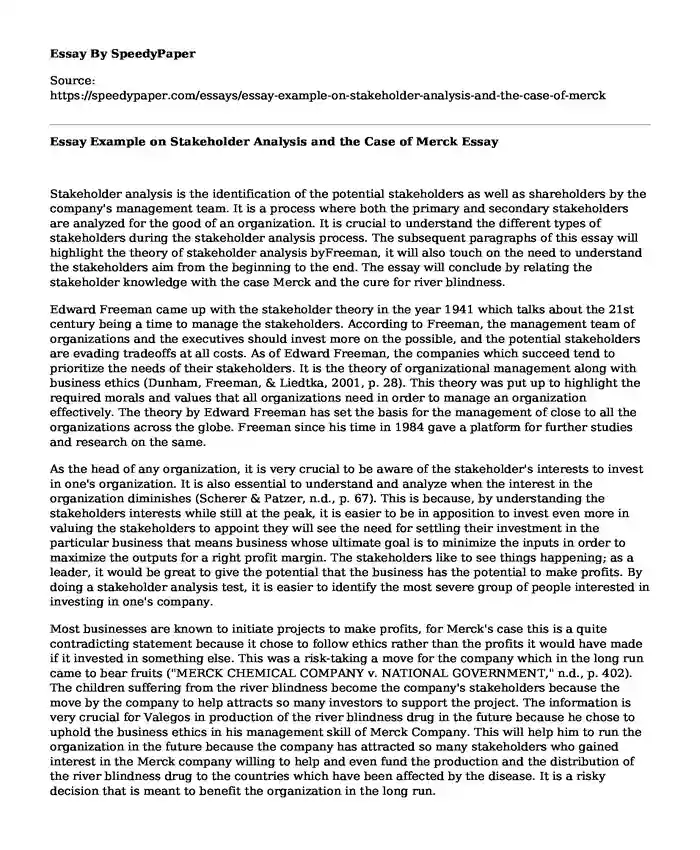
| Type of paper: | Essay |
| Categories: | Company Ethics Financial management |
| Pages: | 3 |
| Wordcount: | 661 words |
Stakeholder analysis is the identification of the potential stakeholders as well as shareholders by the company's management team. It is a process where both the primary and secondary stakeholders are analyzed for the good of an organization. It is crucial to understand the different types of stakeholders during the stakeholder analysis process. The subsequent paragraphs of this essay will highlight the theory of stakeholder analysis byFreeman, it will also touch on the need to understand the stakeholders aim from the beginning to the end. The essay will conclude by relating the stakeholder knowledge with the case Merck and the cure for river blindness.
Edward Freeman came up with the stakeholder theory in the year 1941 which talks about the 21st century being a time to manage the stakeholders. According to Freeman, the management team of organizations and the executives should invest more on the possible, and the potential stakeholders are evading tradeoffs at all costs. As of Edward Freeman, the companies which succeed tend to prioritize the needs of their stakeholders. It is the theory of organizational management along with business ethics (Dunham, Freeman, & Liedtka, 2001, p. 28). This theory was put up to highlight the required morals and values that all organizations need in order to manage an organization effectively. The theory by Edward Freeman has set the basis for the management of close to all the organizations across the globe. Freeman since his time in 1984 gave a platform for further studies and research on the same.
As the head of any organization, it is very crucial to be aware of the stakeholder's interests to invest in one's organization. It is also essential to understand and analyze when the interest in the organization diminishes (Scherer & Patzer, n.d., p. 67). This is because, by understanding the stakeholders interests while still at the peak, it is easier to be in apposition to invest even more in valuing the stakeholders to appoint they will see the need for settling their investment in the particular business that means business whose ultimate goal is to minimize the inputs in order to maximize the outputs for a right profit margin. The stakeholders like to see things happening; as a leader, it would be great to give the potential that the business has the potential to make profits. By doing a stakeholder analysis test, it is easier to identify the most severe group of people interested in investing in one's company.
Most businesses are known to initiate projects to make profits, for Merck's case this is a quite contradicting statement because it chose to follow ethics rather than the profits it would have made if it invested in something else. This was a risk-taking a move for the company which in the long run came to bear fruits ("MERCK CHEMICAL COMPANY v. NATIONAL GOVERNMENT," n.d., p. 402). The children suffering from the river blindness become the company's stakeholders because the move by the company to help attracts so many investors to support the project. The information is very crucial for Valegos in production of the river blindness drug in the future because he chose to uphold the business ethics in his management skill of Merck Company. This will help him to run the organization in the future because the company has attracted so many stakeholders who gained interest in the Merck company willing to help and even fund the production and the distribution of the river blindness drug to the countries which have been affected by the disease. It is a risky decision that is meant to benefit the organization in the long run.
References
Dunham, L., Freeman, R. E., & Liedtka, J. (2001). The Soft Underbelly of Stakeholder Theory: The Role of Community. SSRN Electronic Journal. doi:10.2139/ssrn.284973
MERCK CHEMICAL COMPANY v. NATIONAL GOVERNMENT. (n.d.). International Law Reports, 401-404. doi:10.1017/cbo9781316151440.176
Scherer, A. G., & Patzer, M. (n.d.). Where is the Theory in Stakeholder Theory? A Meta-analysis of the Pluralism in Stakeholder Theory. Stakeholder Theory. doi:10.4337/9780857936349.00012
Cite this page
Essay Example on Stakeholder Analysis and the Case of Merck. (2022, Dec 26). Retrieved from https://speedypaper.net/essays/essay-example-on-stakeholder-analysis-and-the-case-of-merck
Request Removal
If you are the original author of this essay and no longer wish to have it published on the SpeedyPaper website, please click below to request its removal:
- Free Essay Example on Chronic Wound Care
- Free Essay on Professional Development for Teachers
- The Socio-Cultural and Historical Contexts in Hermeneutical Practice, Free Essay
- Free Essay on Developing an Infant-Toddler Curriculum
- Essay Sample: Greek Life as Depicted in the Odyssey
- Free Paper Sample on Implications of Summer 2020 Olympic Games in Tokyo, Japan
- Free Essay: Impacts of Climate Change to the World
Popular categories




